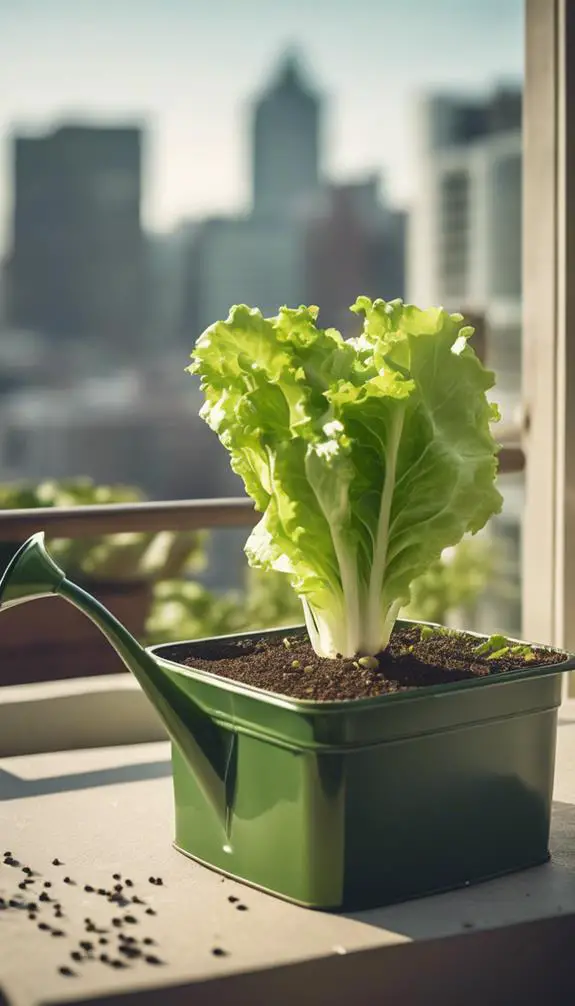You're just a few steps away from enjoying crisp, fresh lettuce right in the comfort of your own home. To get started, you'll need to choose the right variety of lettuce – one that matures quickly and suits your taste buds. With the right seeds in hand, you'll need to select a container that drains well and fill it with a soil mix tailored to lettuce's specific needs. But that's just the beginning. You'll also need to provide the perfect environment, complete with adequate lighting, controlled temperatures, and precise watering. Get these basics right, and you'll be on your way to a bountiful harvest – but what's the secret to keeping your lettuce healthy and thriving?
Summary
- Choose a lettuce variety that matures quickly (40-70 days) and suits your taste preferences, with compact size ideal for indoor growing.
- Select a container with adequate drainage holes, a well-balanced soil mix, and a size of 2-5 gallons with a depth of at least 6-8 inches.
- Sow seeds at the correct depth (1/8 to 1/4 inch) in a well-draining potting mix, and water gently but thoroughly, maintaining consistent moisture.
- Provide 12-16 hours of light per day, with a minimum of 40-50 watts of light per square foot, and maintain an ideal room temperature between 65°F to 70°F (18°C to 21°C).
- Fertilize regularly with a balanced fertilizer, and prune indoor lettuce every 7-10 days to promote better harvests and encourage bushy growth.
Choose the Right Lettuce Variety

When selecting a lettuce variety for indoor growing, consider the maturity days, leaf type, and desired flavor profile.
You'll want to choose a lettuce type that matures quickly, typically between 40-70 days, to guarantee a continuous harvest.
Leafy varieties like loose-leaf, romaine, and buttercrunch are ideal for indoor growing, as they're compact and don't require a lot of space.
If you prefer a sweeter flavor, opt for a red or green leaf variety. If you want a more robust flavor, choose a romaine or buttercrunch.
Consider growing a mix of lettuce types to create a salad blend that suits your taste preferences.
With so many leafy varieties to choose from, you're bound to find the perfect lettuce for your indoor growing needs.
Select a Growing Container

You'll need a container that provides enough room for your lettuce to grow, so consider the mature size of your chosen variety when selecting a container.
The material you choose is also important, as it can affect the health of your plants, with options ranging from traditional plastic or clay pots to more modern materials like fabric or recycled paper.
Regardless of the material, make sure your container has adequate drainage holes to prevent waterlogged soil, which can be detrimental to your lettuce's growth.
Container Size Matters
Two to five-gallon containers are ideal for growing lettuce indoors, as they provide ample room for the roots to spread out while keeping the soil volume manageable.
You'll want to guarantee the container depth is at least 6-8 inches to accommodate the lettuce's root system. A deeper container will give the roots room to grow, but be mindful of the soil volume – too much soil can lead to waterlogged conditions.
Aim for a container that allows for good drainage and aeration. This will help prevent root rot and promote healthy growth. With the right-sized container, you'll be well on your way to growing crisp, delicious lettuce indoors.
Material Choices Abound
Selecting the right material for your growing container is vital, as it directly impacts the health and success of your indoor lettuce crop.
You'll find a wide range of material options available, each with its own set of benefits and drawbacks.
In indoor settings, you'll want a material that's durable, easy to clean, and resistant to moisture.
Plastic and ceramic containers are popular choices, as they're affordable and come in a variety of styles.
Wooden containers can add a touch of rustic charm, but they may require more maintenance.
Fabric pots and self-watering planters are also great options, offering flexibility and convenience.
Consider your specific needs and preferences when choosing a material, and you'll be well on your way to growing a thriving crop of lettuce indoors.
Drainage Is Essential
Proper drainage is the linchpin of a successful indoor lettuce crop, as waterlogged soil can quickly lead to root rot and other problems.
You'll want to select a growing container that allows for good drainage to prevent water pooling. Look for containers with built-in drainage holes or a well-designed water reservoir system.
Soil porosity is also vital, as it enables excess water to escape while retaining the right amount of moisture for your lettuce.
Avoid using solid-bottom containers or those with poor drainage, as they can lead to waterlogged soil. Instead, opt for containers with a mesh or screen bottom, or those specifically designed for indoor gardening with built-in drainage features.
Prepare the Soil Mix

Crafting a well-balanced soil mix is critical for growing robust, healthy lettuce indoors, as it provides the necessary nutrients and supports ideal root development.
You'll want to create a soil composition that's specifically tailored to lettuce's needs. Aim for a mix that's 50-60% organic matter, such as peat moss or coconut coir, and 40-50% inorganic matter, like perlite or vermiculite.
Add organic amendments like compost, worm castings, or well-rotted manure to enhance the soil's fertility and structure. Avoid using regular potting soil, as it can be too dense and may hinder drainage.
Sow the Lettuce Seeds

You'll need to select a suitable lettuce variety for indoor growing, considering factors like growth rate, leaf type, and disease resistance.
Next, prepare your seeds for sowing by gently removing them from their packaging and taking note of the recommended sowing depth, which typically ranges from 1/8 to 1/4 inch deep.
With your seeds and soil mix ready, you're set to sow your lettuce seeds at the correct depth to guarantee perfect germination.
Lettuce Seed Selection
Choosing the right lettuce seeds is essential for a successful indoor harvest.
You'll want to select high-quality seeds that are suitable for indoor growing and resistant to common lettuce diseases. Consider the lettuce history, as some varieties have been bred specifically for indoor cultivation.
Look for seeds that are certified disease-free and have a high germination rate. Seed quality is pivotal, as low-quality seeds can lead to poor germination, weak seedlings, and reduced yields.
Opt for seeds from reputable suppliers that provide detailed information on seed characteristics, such as days to maturity, growth habit, and flavor profile. By choosing the right seeds, you'll set yourself up for success and enjoy a bountiful indoor harvest.
Lettuce Sowing Depths
Get ready to sow your lettuce seeds at the ideal depth.
For perfect lettuce germination, sow the seeds 1/8 inch deep and 2-4 inches apart. This allows for proper seedling spacing and air circulation.
Sowing too deep can lead to rot and poor germination. Use a seed starting mix or a well-draining potting mix to prevent waterlogging.
Gently firm the soil over the seeds to secure them in place. Water the soil gently but thoroughly.
Make sure the soil is consistently moist during the germination period, which typically takes 7-10 days.
Provide Adequate Lighting
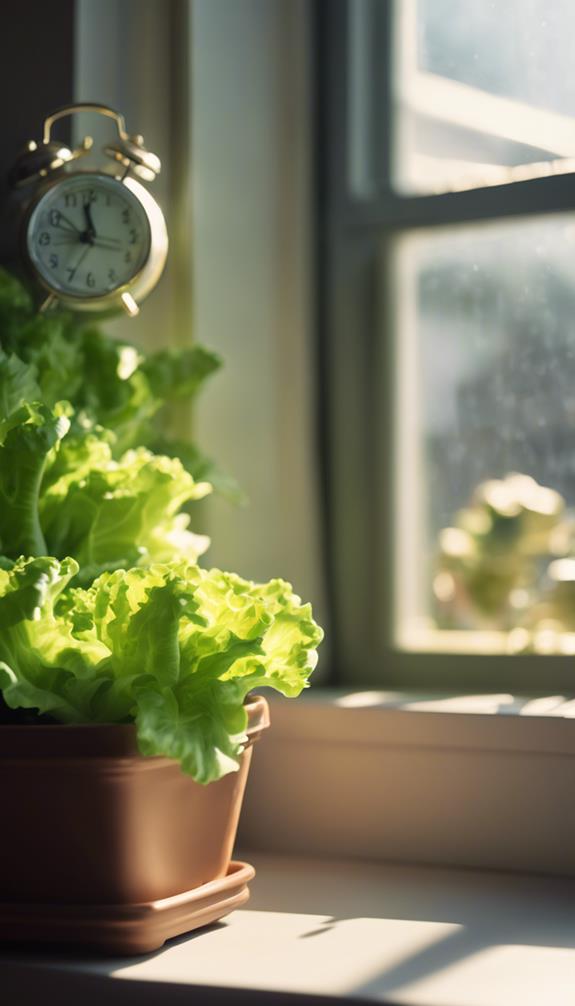
Adequate lighting is crucial for growing lettuce indoors, as it directly impacts photosynthesis and consequently the plant's growth rate and quality.
You'll want to guarantee your lettuce receives 12-16 hours of light per day. To achieve this, consider using lighting timers to automate the process.
If you don't have grow lights, alternatives include placing your lettuce near a sunny window or using LED light strips. Aim for a minimum of 40-50 watts of light per square foot.
You can also experiment with different lighting spectrums, such as blue or red light, to maximize growth. By providing your lettuce with the right amount and type of light, you'll be on your way to a flourishing indoor harvest.
Maintain Optimal Temperature
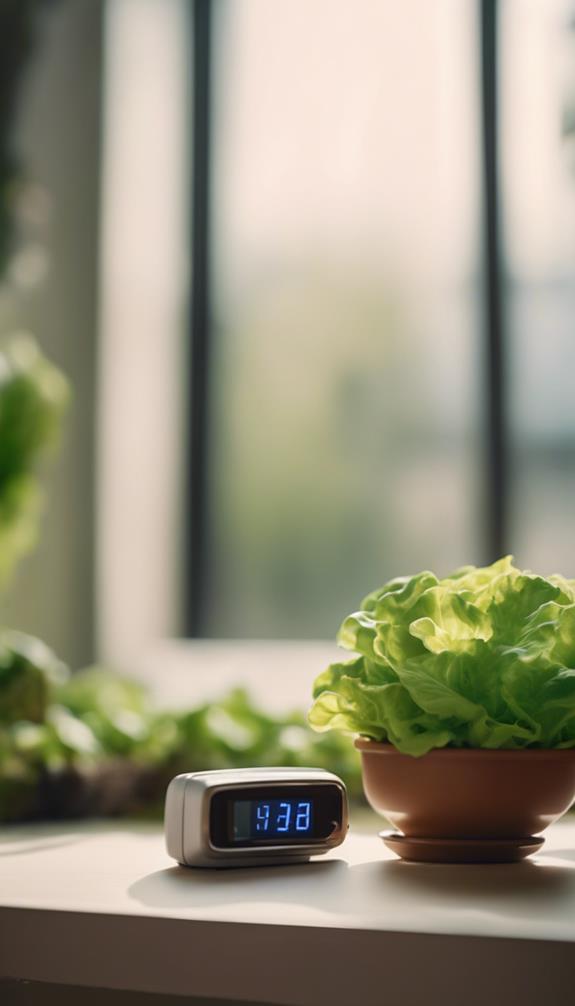
You'll want to maintain an ideal room temperature between 65°F to 70°F (18°C to 21°C) for perfect lettuce growth.
However, lettuce is tolerant of a range of temperatures, from 55°F to 75°F (13°C to 24°C), but temperatures outside this range can negatively impact growth.
Cooler nights, around 55°F to 60°F (13°C to 16°C), can even benefit lettuce, as this temperature drop can stimulate growth and reduce bolting.
Ideal Room Temperature
How essential is room temperature in growing lettuce indoors? It's pivotal, as lettuce requires a specific climate to thrive.
You'll want to maintain an ideal room temperature between 60°F to 70°F (15°C to 21°C), which falls within the prime climate zones for lettuce growth. This temperature range allows for peak photosynthesis and healthy development.
Be mindful of temperature fluctuations, as they can stunt growth or even kill your lettuce. Avoid placing your indoor lettuce garden near heating vents, air conditioning units, or drafty windows, which can cause temperature swings.
Lettuce Tolerance Range
Frequently, indoor gardeners wonder about the flexibility of lettuce when it comes to temperature deviations.
You'll be relieved to know that lettuce has a relatively broad temperature tolerance range. While the ideal temperature for lettuce growth is between 60°F to 70°F (15°C to 21°C), it can still thrive in temperatures as low as 40°F (4°C) and as high as 80°F (27°C).
However, prolonged exposure to temperature fluctuations can affect lettuce hardiness. If you're expecting a sudden drop or spike in temperature, take precautions to maintain a stable environment. By doing so, you'll guarantee your lettuce crop remains healthy and productive.
Cooler Nights Benefit
Maintaining ideal temperature is essential for healthy lettuce growth, and cooler nights can be particularly beneficial.
You'll want to replicate cooler climates indoors, especially during nighttime hours, to stimulate lettuce growth. Aim for a temperature range of 60-65°F (15-18°C) during the night, as this will promote healthy leaf development.
The nighttime benefits of cooler temperatures include increased sugar production, which enhances the flavor and texture of your lettuce.
Water Correctly and Consistently
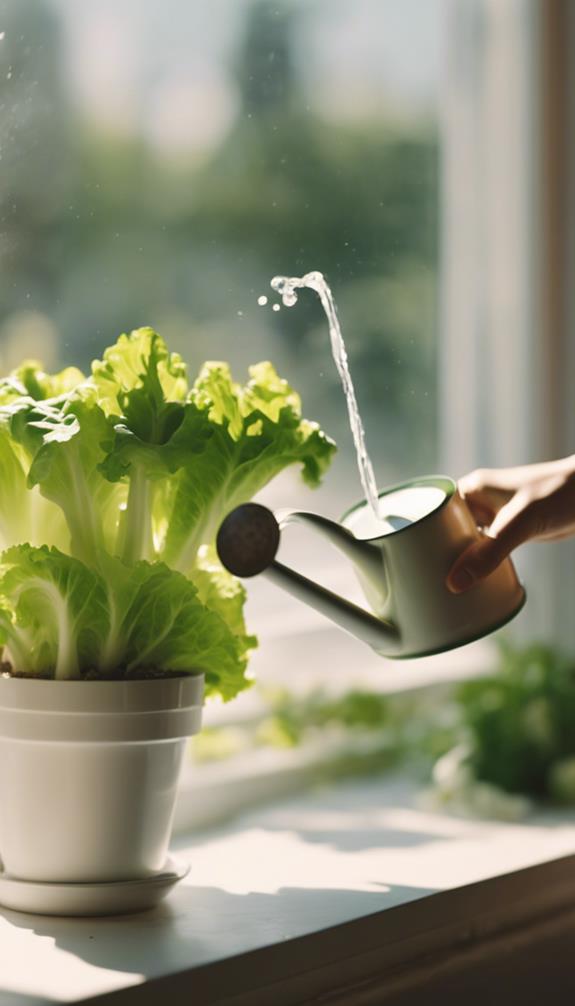
Your indoor lettuce garden's success hinges on watering correctly and consistently.
You'll want to establish a watering schedule that guarantees your plants receive the right amount of moisture. Check the soil daily, and water only when the top inch of soil feels dry to the touch.
Avoid overwatering, which can lead to root rot and other problems. Instead, aim to maintain ideal moisture levels between 40% and 60%.
Water at the base of the plants to prevent leaves from getting wet, reducing the risk of fungal diseases.
Fertilize for Healthy Growth

Regularly, you'll need to fertilize your indoor lettuce to promote healthy growth and maximize yields.
A balanced fertilizer with equal nitrogen, phosphorus, and potassium (NPK) ratios is ideal. You can opt for a water-soluble fertilizer or a fertilizer specifically formulated for leafy greens like lettuce.
Create a fertilizer schedule to guarantee consistent application. Feed your lettuce every 1-2 weeks, depending on the brand's instructions.
Consider using lettuce boosters, which provide an extra dose of nutrients for peak growth. Avoid overfertilizing, as this can lead to weakened roots and reduced yields.
Stick to your fertilizer schedule, and you'll be harvesting fresh, nutritious lettuce in no time.
Prune for Better Harvests
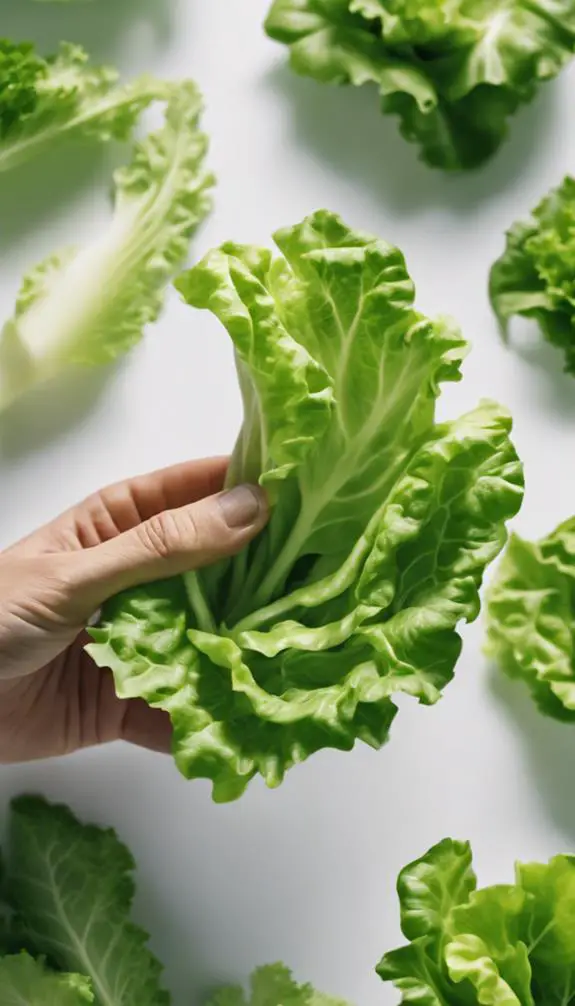
As you fertilize your indoor lettuce, you'll also need to prune it regularly to promote better harvests and encourage bushy growth.
Prune timing is vital, as it affects the quality and quantity of your yields. Aim to prune your lettuce when it reaches 4-6 inches in height, usually every 7-10 days. This frequency encourages the plant to focus energy on producing leaves rather than flowering.
To prune, simply pinch or cut off the top inch of the plant, just above a leaf node. This will stimulate the growth of new leaves and prevent the plant from becoming leggy.
Monitor for Pests and Diseases

Inspect your indoor lettuce crop frequently for signs of pests or diseases, which can quickly decimate your harvest if left unchecked.
Check for pest attractants like moist soil, high humidity, and decaying organic matter. Remove any debris or weeds that may be harboring pests.
Regularly examine your lettuce leaves for holes, discoloration, or distortion. Fungal diseases often cause white or gray powdery patches, while bacterial diseases lead to soft, mushy spots.
Implement disease prevention methods like crop rotation, sanitation, and avoiding overwatering. Certify good air circulation around your plants to prevent moisture buildup. Keep your growing area clean, and dispose of any infected plants to prevent the spread of disease.
Control Humidity and Airflow

By the time your indoor lettuce crop is thriving, you'll want to guarantee ideal humidity and airflow to prevent moisture buildup.
Regular humidity checks will certify your lettuce grows in a healthy environment. Aim for a relative humidity of 40-60% to prevent fungal diseases.
Implementing an airflow system is vital to maintain air circulation and prevent stagnant air. This can be achieved through the use of fans or vents that exchange stale air for fresh air.
Certify good air movement around plants by providing adequate spacing and pruning nearby foliage. By controlling humidity and airflow, you'll create a prime environment for your lettuce to thrive.
Harvest at the Right Time

Your crisp, green lettuce leaves are finally ready to be harvested, and timing is everything.
To guarantee prime leaf quality, you'll want to harvest your lettuce at the right frequency. For loose-leaf varieties, harvest individual leaves as needed, leaving at least 1 inch of stem intact to encourage regrowth.
For head-forming varieties, wait until the entire head is mature, then cut it off just above the soil line.
Harvesting at the right time will encourage continuous growth and prevent bolting, which can lead to bitter-tasting leaves.
Aim to harvest every 3-5 days for loose-leaf varieties and every 7-10 days for head-forming varieties to maintain a steady supply of fresh, crisp lettuce.
Store Lettuce Freshly Picked

Store Lettuce Freshly Picked
Freshly picked lettuce requires prompt storage to maintain its crisp texture and sweet flavor.
You'll want to store it in a way that prevents moisture buildup and promotes air circulation. To achieve this, gently pat the leaves dry with a clean towel or paper towels to remove excess moisture.
Then, place the lettuce in a breathable container or bag, such as a mesh or paper bag, and store it in the refrigerator at a consistent temperature below 40°F (4°C).
FAQs
Can I Grow Lettuce Indoors Without a Green Thumb?
You don't need a green thumb to grow lettuce indoors; with proper urban gardening techniques, you can thrive in any indoor climate by controlling temperature, humidity, and light, making it easy to harvest fresh lettuce year-round.
How Often Should I Rotate My Lettuce Containers?
You'll want to rotate your lettuce containers every 2-3 days to maintain ideal lettuce orientation, ensuring even light exposure and preventing uneven growth. Proper container placement is key, so adjust accordingly to promote healthy, uniform development.
Can I Use a Regular Pot Instead of a Growing Container?
You can use a regular pot, but guarantee it's at least 6-8 inches deep to accommodate lettuce's shallow roots. Choose a pot size that allows for 2-3 inches of soil depth between the soil surface and the pot's rim for peak growth.
Is It Necessary to Wash Lettuce Before Eating It?
You'll want to wash your fresh greens to guarantee a clean crunch; rinse them gently with cool water to remove dirt and debris, then dry thoroughly to prevent moisture-related spoilage and foodborne illness.
Can I Grow Lettuce Indoors Year-Round or Only Seasonally?
You can grow lettuce year-round indoors, regardless of outdoor climate, by controlling indoor conditions, such as temperature, humidity, and light, to create an ideal environment that fosters continuous growth and harvest.
Conclusion
You've successfully grown lettuce indoors! Now, harvest your crisp, fresh leaves regularly to encourage continuous growth. Store them in a sealed container in the refrigerator to maintain peak freshness. Keep the soil moist, and fertilize every 1-2 weeks to promote healthy growth. With proper care, you'll enjoy a bountiful supply of fresh lettuce year-round.




